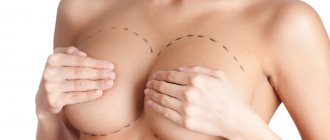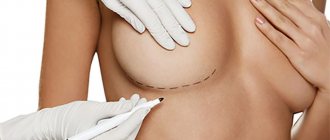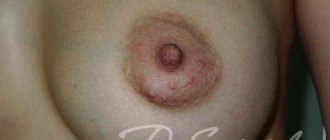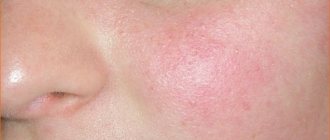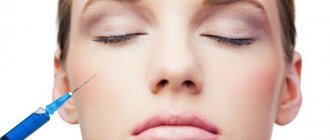Beginning and period of development
In anatomy, there are several stages of female breast development, each of which has specific processes.
From birth to 9.5 – 10.5 years
At this stage, girls' busts are no different from boys' chests. They have a flat shape and do not develop in any way.
From 10.5 to 11.5 years
The breast formation mechanism starts. Although young creatures may not notice the beginning of its maturation.
The development process is quite slow. However, at this stage, the areolas become darker in color and become wider. Minor bulges appear under the nipples.
From 12.5 to 13 years
Slowly but noticeably the parameters of the mammary glands change.
The shape of the breast also changes - from flat to cone-shaped, which only becomes rounded over time. The bulges around the areolas become even larger. At the same time, nipple growth also occurs. For most girls, they protrude above the surface of the areolas. However, nipples can also have a flat shape, and this is not a pathology.
From 13 to 13.5 years
This stage of development is characterized by the process of increasing the volume of the mammary glands. The breasts become visually more noticeable.
However, not all girls' bust shapes have acquired their final form. This is why they may look like a bulge on a bulge. That is, on the most “swollen” mammary gland, a swollen areola protrudes.
From 13.5 to 15 years
The process of breast formation ends. The increase in volume stops, the mammary glands acquire their final shape. The breast, on which the nipple protrudes, becomes rounded.
After 15 years
For some girls, the stage of completion of breast growth can last up to 24-25 years. However, no significant changes occur during this period.
The bust may increase in volume or change dramatically during pregnancy or after childbirth.
What affects breast growth (7 factors)
How your breasts will grow and how long it will take depends on several factors:
- Maintaining proper nutrition.
- Features of body structure. As a rule, short and petite girls will not have large breasts, unlike taller beauties who are prone to obesity.
- It also depends a lot on the girl’s health.
- Genetics. Often, many girls develop breasts in the same way as their relatives.
- Weight control. You should not go on diets during the formation of the mammary glands; diets or, on the contrary, excess weight can negatively affect breast development.
- Hormones. Hormone levels change depending on the stage of a woman’s life, with particularly noticeable surges. These are adolescence, menstruation, pregnancy and menopause.
- Physical exercises can correct the shape of the breasts, but not their size, since they are not muscle, but fat deposits.
Breast formation is also a very difficult process for girls from a psychological point of view. The new bulges seem too small to some, and too large to others.
Teenagers have a hard time experiencing any changes, both external and those that happen to them personally. Puberty can bring up a lot of emotions in a girl.
Therefore, parents should talk with their child about this difficult period of her life even before it comes, so that she understands that all the changes happening to her are the norm and there is nothing bad about it. It is important to teach a girl to accept her changes.
During the period of breast growth, you need to especially carefully monitor your diet, eat more plant-based and healthy foods. Do not overeat fatty foods.
Reasons for deviations
If the elasticity of the breast depends on the strength of the fibers that form the connecting frame of the mammary glands, then its volume is influenced by many factors.
Small size may be due to certain factors:
- Amount of adipose tissue. Of course, to a greater extent, the volume of the breast is formed by the glandular component, but the girl’s weight also plays an important role.
When you lose body weight, it is not the waist and hip measurements that first decrease, but the size of the mammary glands. Gaining weight, on the contrary, leads to an increase in volume. An extra kilogram is equal to 20 grams of breast fat. - Genetic inheritance. The daughters of curvy women do not always develop identical breast sizes.
Or the sisters have far from the same parameters of the mammary glands. Genetic predisposition is not the last, but not the first place in the development of the female body. - Disorders of the endocrine system and the thyroid gland, in particular, which play an important role in the production of hormones.
- Vitamin deficiency - the lack of substances and microelements necessary for the development of the teenage body negatively affects the process of puberty.
- Sports hobbies. Physical activity usually helps burn fat tissue, which is an important component of the mammary glands.
- Lack of estrogen - female hormones that trigger puberty.
Their excess in the male body leads to breast growth. Some girls try to increase their bust size by taking hormonal medications. However, uncontrolled use of this category of pharmaceuticals can lead to dire consequences. - Nervous breakdowns, stress. Disturbances in the psycho-emotional state of a teenager can significantly affect the development of his body.
- Diet. There are a number of products that can normalize hormonal levels and replenish the body with fat cells - milk, cheese, kefir, chicken, olives, avocado and others.
- Ecology. Clean air and favorable environmental conditions contribute not only to the proper formation of breasts, but are also the key to good health.
- Injuries. This does not necessarily damage the chest. Serious head injuries can also interfere with breast growth, which lead to destabilization of the hypothalamic-pituitary system, which is responsible for the formation of the mammary glands.
- Congenital pathologies . According to statistics, in 3% of the female population of the planet, the cause of breast underdevelopment is intrauterine anomalies.
Note! It is important for girls between the ages of 13 and 18 to eat well and not exhaust their bodies with all kinds of diets. Otherwise, in the future they will not be able to increase breast volume even if they gain weight.
From the video you will learn how long it takes for female breasts to grow and what it depends on.
How do mammary glands develop in women?
As already mentioned, there is no identical starting date for breast growth in girls; it can vary taking into account many factors, including heredity and body characteristics.
Affects breast development and the place in which girls are born. Thus, in women living in warm climates, development occurs faster, their figure takes on feminine contours earlier, however, aging also occurs faster.
Girls living in cold climates experience puberty later, and as a nice bonus, they remain youthful longer.
When discussing why breasts do not grow: what to do, you need to focus on the periods of development of the mammary glands. Doctors conventionally divide the formation of mammary glands into several periods.
Visible changes in the mammary glands in girls can begin between the ages of nine and twelve years. The changes are expressed in a slight coarsening of the papillae and swelling of the skin around them.
From twelve to fourteen years, the mammary glands increase in size, the papillae darken, and the breasts become slightly elongated. In some girls, by the age of 14, breasts may increase to size 1. The third period covers a conventional period of time from 13 to 15 years, at this time the mammary glands become rounded with pronounced areolas around the nipples. At this time, the girls are already wearing underwear. Those whose breasts have developed to the first size can wear traditional bras, however, doctors do not recommend choosing models with underwires; other representatives of the fair sex opt for various tops.
The final period of formation of the mammary glands is considered to be the age from fifteen to eighteen, or even up to twenty years.
On average, the mammary glands begin to grow from the age of thirteen; at fifteen years of age changes should be visible to the naked eye, and by the age of eighteen the breasts are formed to their size determined by nature and physiology.
Diagnostics
If by the age of 15 the breasts have not acquired the expected size and shape, you can visit a number of specialists and undergo a thorough examination to find out the reason for this development of events.
First of all, you should go to an appointment with a gynecologist or mammologist. Specialists can assess the condition of the mammary glands and suggest existing problems.
You may also need to additionally consult an endocrinologist.
In general, in the presence of developmental defects, a comprehensive diagnosis is prescribed, which consists of:
- blood test for hormones;
- ultrasound examination of the pelvic organs and thyroid gland;
- Ultrasound of the mammary glands.
This list can be expanded with additional examinations as a result of a visual examination and anamnesis collection by specialists.
Useful tips on how to enlarge your breasts at home using exercises, massage and other methods. Read here why one breast is larger than the other.
At this address https://cosmetolog-expert.ru/plastika-tela/grudi/uvelichenie-g/vse-za-i-protiv-na-osnove-gialuronovoy-kislotyi.html let's talk about the price of breast augmentation with hyaluronic acid.
Heredity
Genetic information received from parents is the main factor determining the size and shape of a woman's breasts during adolescence and adulthood. If the father or mother (or both at once) did not have curvaceous figures in the family, then the daughter may have small breasts.
Genes also determine the time of onset and duration of puberty, a period one of the characteristics of which is the development of the mammary glands. If changes in breast size are not observed at 14-16 years of age, you should consult a doctor.
Heredity is also responsible for the condition of the bust during pregnancy. If the majority of women in the family's breasts grew little or quickly returned to their previous size after breastfeeding began, with a high probability the same will be true for all representatives of the family.
The influence of the hereditary factor also concerns the structure of the body (“apple”, “hourglass”, “triangle”, etc.). The final figure of a woman is formed by lifestyle, nutrition, ecology and past illnesses. But in “sports” families, children are usually thin, thanks to the metabolic rate transmitted by their parents.
Dealing with heredity is difficult. The only way to achieve significant breast enlargement is surgery.
Despite their size, small breasts, due to heredity, are fully developed and perform the functions assigned to them in producing milk and feeding the child.
Treatment
The absence of curvy figures is not a disease, so the concept of “treatment” in this case has a slightly different meaning. It is much more correct to present to your attention ways to increase breast size.
Hormone therapy
Based on blood test results for hormones, one can judge whether there is a deficiency of a certain type of these substances. The resulting picture can be corrected using special preparations.
Birth control pills can change the hormonal levels in the body. The use of this drug actually increases the size of the mammary glands. However, the effect of therapy lasts only as long as you take the pills.
By replenishing the deficiency of thyroid hormones, noticeable results can be achieved. Prompt treatment can increase the size permanently.
However, it is worth remembering that each body is individual and may respond differently to taking hormonal drugs.
Therefore, before starting therapy, it is necessary to discuss with a specialist all possible consequences and the duration of the effect obtained.
Breast augmentation surgery
Only surgical intervention can guarantee you the most lasting and planned result. You can resort to plastic surgery only from the age of 18.
In this case, the specialist must first prescribe a thorough examination , which will confirm the completion of the independent process of breast formation.
In addition, it is better to increase the volume for women who have not yet given birth.
other methods
You can increase elasticity and transform the shape of your bust using alternative methods:
- change in diet - a woman’s diet should consist of foods rich in fat cells and phytoesterogens. In addition, you can periodically take vitamin complexes;
- massage - there are a number of techniques that make it possible to increase the tone and elasticity of the mammary glands;
- performing physical exercises for the chest;
- topical cosmetics
- improvement of blood supply due to contrast shower;
- professional cosmetological methods , such as augmentation with your own fat, injections and others;
- Deception of the eyes of others in the form of wearing push-up underwear.
Expert opinion
- Cosmetologist
- Surgeon
Irina Dorofeeva
practicing cosmetologist
Before puberty, a girl’s activity generally increases, and the occurrence of menstruation indicates a new stage of human development. It is at this time that active growth of the mammary glands is observed, but they begin to grow even earlier (several years in advance). On average, this happens around the age of 11, and most girls experience menstruation at 13-14 years old. If breast growth does not begin at this age, do not worry, since each body is individual. Sometimes this process occurs later.
Michelle Place
plastic surgeon
Breasts begin to form at the age of 10-12 years.
Often during this period, girls complain of itching as the skin stretches. Pain may also occur. Active growth of the mammary glands occurs later. If no changes are observed at the age of 16-18, you should consult a doctor to determine the cause. Thus, no matter what the breast size and the woman’s level of satisfaction with it, before resorting to decisive action, you need to consult a specialist, and also independently weigh the pros and cons.
And the most important thing that all women should remember is that you need to learn to accept yourself as you are and then others will treat you the same.
Will cabbage help?
Many girls believe that the more cabbage is present in the diet, the more curvy they are. However, this statement is a myth. Scientists in our country and abroad have conducted more than one study of such an extraordinary connection and have refuted it.
But cabbage contains many useful microelements that are beneficial for the health of the body. Consumption of this vegetable, although it will not increase volume, can prevent the development of various neoplasms, mastitis and increase elasticity.
Pros and cons of the method of breast augmentation using your own fat and the procedure technique. In this publication we will discuss the price of breast augmentation surgery.
Follow the link https://cosmetolog-expert.ru/plastika-tela/grudi/podtyazhka/bez-implantov.html if you are interested in reviews about breast lift without implants.
Female bust - stages of development
To understand how breasts form and how many years they grow, doctors divided the stages of development of a woman’s bust into five phases:
Stage I. Infancy.
We will not be able to distinguish between the breasts of a newborn girl and a boy. But still there is a difference. On the baby's chest area, under the nipples, there is a thin line - it is called the “milk line”. This is the outer end of the colostrum tubes. Sometimes they are also present in newborn boys - they later disappear.
Discharge from the mammary line in the first days of birth is normal in female infants. This indicates that in the future the baby will grow into a charming girl, and full breasts will form from the milk line. Until what age? The bust grows until the age of 17-20, but can change over the course of life.
Stage II. Puberty.
In a carefree childhood, girls’ mammary glands “sleep.” The impetus for the development of the mammary glands is given by the onset of puberty. As soon as this hour comes, small bulges form around the circumference of the nipples, and the nipples and areolas themselves swell.
It is difficult to predict when to expect this period. Modern children are too individual - for some, the period of maturity begins even at 8 years old, for others at 13-14.
During the transformation of a girl into a young woman, the mammary gland changes size. But at this stage it is difficult to understand how the breasts grow and what they will become. This is the beginning of development.
Stage III. Growing up.
The time when breasts really start to grow. The mammary glands gain elasticity, and the nipples and areolas become more clearly defined. The development of the bust at this stage indicates that the girl is prepared for sexual activity and is able to bear a child.
Stage IV. Pregnancy.
A difficult stage in a woman’s life; global changes begin in her mammary glands. The process of their formation at this time will be completed only at the end of the lactation period. During pregnancy, the bust grows evenly, in proportion to the tummy. In the last days before childbirth, the glands are filled with milk. Before the baby is born, milk is released from the nipples - the breast is waiting for its little owner.
They say that a woman who has not experienced pregnancy and motherhood is not able to fully develop the mammary glands.
During this period, the female bust becomes attractive and blooming. With the advent of the baby, until the end of the breastfeeding period, changes in the areola and nipples occur in the mammary glands. They (the changes) remain with women until the end of their lives.
V stage. Aging.
Nothing lasts forever in this world. A woman's breasts, just like their mistress, are aging. At this stage, those with small bust sizes win. Compared to busty breasts, whose mammary glands change from “large” to “long” in old age, small breasts remain unchanged.
But internal processes in the aging body (loss of collagen, elasticity, tone) apply to any bust. After menopause, the mammary glands lose their natural functions, their sensitivity decreases, their appearance changes, and they sag.
«My breasts are so perky now – I can easily carry them up, down, even in different directions.
“,” one famous actress spoke with humor about her bust during this period. But this time is still far away, and lush breasts are needed immediately.
Pros of a small bust
As a rule, the culprits of complexes regarding small breast size are women themselves.
Not everyone likes curvy figures, and there are a number of advantages to having a small bust:
- Small breasts in most cases have an attractive shape, which does not lose its charm after childbirth.
- Women with small breast volume are less likely to suffer from spinal problems.
- Small shapes do not create difficulties when choosing underwear or during some sports activities.
- There is a popular belief that women with small breasts look much younger than women with large busts.
- Visually it is much easier to increase the size than to hide it. For this purpose, there are many types of linen and inserts on the market today.
Find out what you can do if a girl has small breasts from the video.
Why do some girls have small breasts while others have large ones?
The size of a woman's breast depends on the amount of fatty tissue it contains. The mammary glands themselves, which produce milk for feeding the baby, are the same in all women and this does not depend on the size of her breasts.
Therefore, you should not assume that if a person has small breasts, then there will be no milk in them or there will be less milk. It's all about the mammary glands, and as already mentioned, they are all the same size.
Girls with a dense build have larger breasts due to the large amount of fatty tissue, while thin girls have smaller breasts.
There are also other reasons why breasts may be small, but it is impossible to determine them on your own. If you have any questions about your breasts, it is better to consult a mammologist.
Genetics
If along the line a mother, grandmother, aunt, etc. had a small breast size, then it is likely that this can be passed on to the child hereditarily. The mammary gland will form, and the breasts will reach a certain size and will no longer grow.
Chromosome set
It also happens that during conception, the chromosomes that are responsible for puberty in the unborn child are poorly produced. In this case, the breast may either not develop at all, or do it poorly, even if everything is fine at the genetic level.
Lack of vitamins
If a girl at the time of puberty does not receive enough necessary vitamins, but all processes slow down or stop altogether. The same applies to the chest. This especially happens to those who live in countries where the standard of living is low and people eat junk food.
Amount of estrogen
Estrogen is a hormone that is responsible for the processes occurring in the human body, the same thing happens with the mammary glands. If it is deficient, a woman's breasts will either not grow at all, or it will happen very slowly.
If the hormone is absent in the body, then the process of puberty will most likely not even start. In this case, medical supervision and examination of the thyroid gland, adrenal glands and appendages are necessary.
Injuries
When actively involved in sports, the muscles are well pumped around the chest, and this can hinder its growth. A girl must decide what is more important to her: lush breasts or sports activities.
Bad ecology
Poor ecology, namely dirty air, dust, dirty water, etc., can inhibit natural processes in the body, breasts are no exception.
What to do to make breasts grow faster?
The rate of breast growth, as well as the approximate volume of the bust, depends on heredity. Therefore, take a closer look at your mother and grandmother, ask them when their bust began to increase. This way you can understand what to expect.
But what if your breasts grow slower than your mother or grandmother at your age? Is it possible to do something about this? In most cases, yes.
Factors influencing the rate of breast growth
- Estrogens. These are female sex hormones. Both health and beauty directly depend on them. If there is not enough estrogen, the breasts grow more slowly or do not grow at all. Lack of hormones can be caused by poor diet, lack of vitamins (particularly vitamin E) and minerals.
- Excessive physical activity. They also affect the production of estrogen, but it is better to discuss this issue separately. Physical activity is good in moderation. If a girl is involved in sports professionally from an early age or adolescence, her sexual development slows down. There may be irregularities in the menstrual cycle, a decrease in the rate of breast growth, and a boyish physique in general. Only reducing the amount and intensity of physical activity will help here. You will have to choose - health and larger breast size or professional sports.
- Stress. Yes, they can also slow down breast growth. Especially if you regularly find yourself in stressful situations.
- Unhealthy Lifestyle. Have you noticed that in villages or provinces girls more often have an impressive bust than their urban counterparts? Most likely, they owe this to fresh air, a nutritious healthy diet, ecology, and sufficient physical activity. Of course, you don’t have to move to the countryside for the sake of beautiful breasts. Any city girl can take care of high-quality and varied nutrition, frequent walks in the fresh air, physical education and proper rest.
- Excessive thinness. Breasts are muscle and fat tissue. Moreover, the second one is responsible for the volume of the bust. Breasts will not be able to fully grow if your body is sorely lacking in fat tissue.
- Improper functioning of organs or their diseases. The “culprits” may be the thyroid gland, pituitary gland, ovaries, adrenal glands.
If you think that your breasts are growing slowly, it is better not to guess what is wrong and not to self-medicate. Even if the issue is a lack of vitamins or poor nutrition, not every girl will be able to create the right diet for herself. It is better to consult a doctor with such questions.



